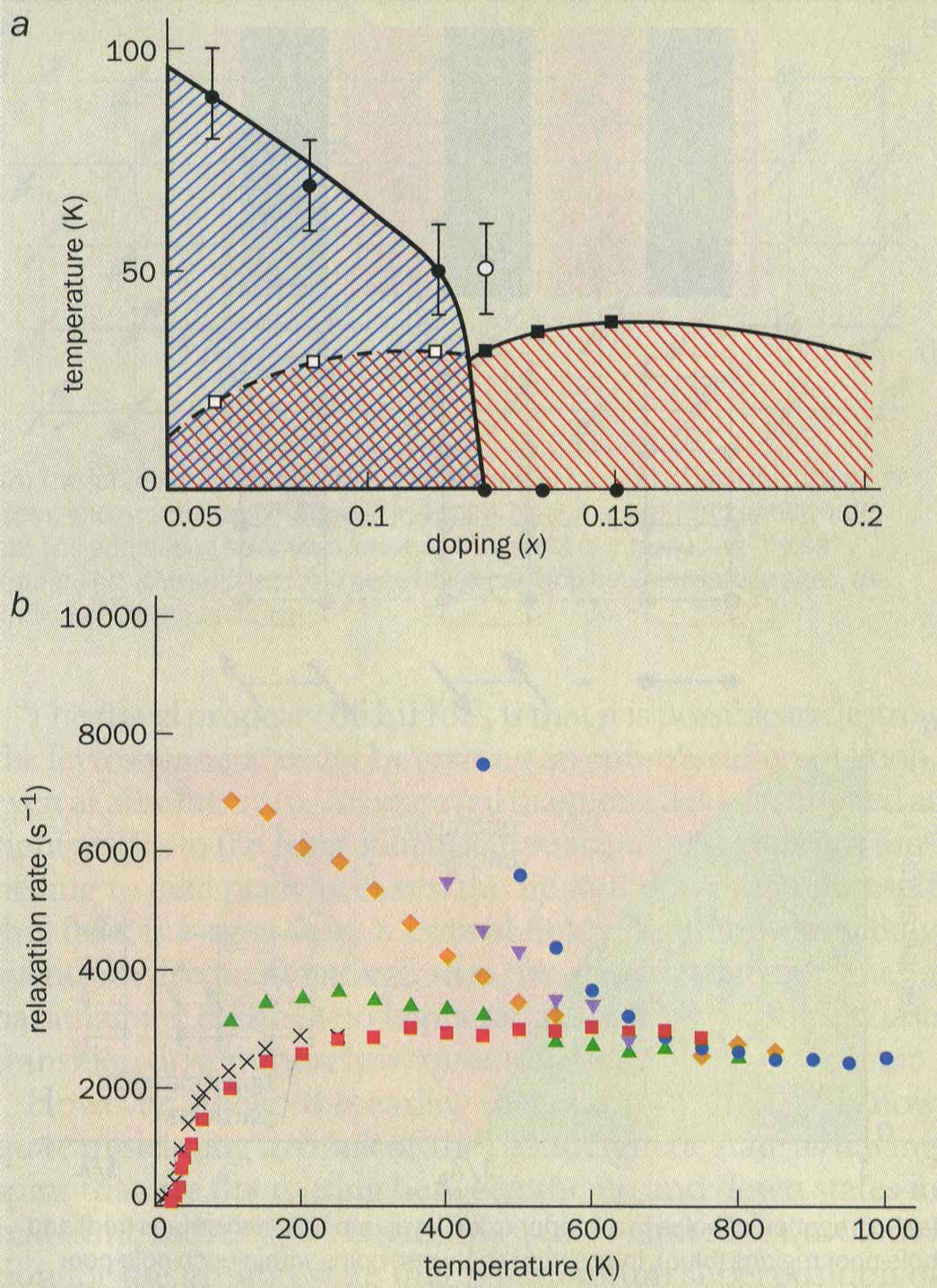PREVIOUS; TABLE OF CONTENTS
5 Experiments on superconductors
Various experimental techniques can be used to test the theoretical picture outlined above. Initial evidence for the localization of holes, possibly in stripes, appeared in measurements by Gregory Boebinger of the Los Alamos National Laboratory and collaborators in 1996. More details emerged in ingenious experiments by Takashi Imai's group at the Massachusetts Institute of Technology (MIT). Imai and co-workers used measurements of nuclear quadrupole resonance in copper-63 to determine which parts of the T-x phase diagram exhibited charge stripes(Fig 4a). Within the striped region, they were able to follow the spin dynamics by measuring a nuclear magnetic resonance relaxation rate, and observed three distinct types of behaviour which neatly correspond to the three regions of the theoretical phase diagram (Fig 4b).
|
Figure 4: Relaxation times and quantum criticality
|
|
 |
|
( a) Phase diagram of La 2-x Sr x Cu O 4 as measured by the magnetic resonance experiments at MIT (Hunt et al [ 4]). There is quasi-static charge stripe order, over the blue hatched region. Superconductivity is present in the red hatched regions. The measurements indicate quasi-classical wave (particle) behavior at low (high) doping.
( b) Measurements of the nuclear relaxation rate as a function of temperature for zero doping (blue circles), x = 0.02 (purple triangles), x = 0.04 (orange diamonds), x = 0.075 (green triangles), x = 0.115 (black crosses) and x = 0.15 (red squares). The relaxation time is a measure of the density of states for the low-energy spin excitations. The three types of behavior shown in Fig 3c can be observed in these measurements, as discussed in the text. |
For small values of the doping, x, the relaxation rate increases rapidly as the temperature is lowered: this is precisely the behaviour expected in the quasi-classical wave regime. At higher temperatures, the relaxation rate is independent of both temperature and the amount of doping, as expected in the quantum critical region. Notice also that for certain intermediate values of x the relaxation rate remains independent of temperature down to rather low temperatures, as we would expect for l » lc. Subsequent neutron scattering experiments by Aeppli, Thomas Mason of the Oak Ridge National Laboratory and others have confirmed this picture by observing spin correlations characteristic of the quantum critical region. Quantum critical behavior is seen for a range of temperatures between 50 K and 350 K.
Finally, for larger x, we see that, below about 200 K the relaxation rate decreases with temperature: this is a characteristic property of the quasi-classical particle regime. This last interpretation is also consistent with neutron scattering measurements by the late Jean Rossat-Mignod of the Centre d'Etudes Nucleaires de Grenoble in France, Herb Mook of Oak Ridge, Bernhard Keimer of Princeton University, Philippe Bourges of the Laboratoire Léon Brillouin in Saclay, near Paris, and others. A sharp "resonance" peak believed to be an S = 1 particle excitation appears in the scattering cross-section at low temperatures.
The above concordance between theory and experiments suggests that a reasonable understanding of the spin fluctuations has been achieved, at least at intermediate energy scales corresponding to temperatures in the range 100-1000 K. At even lower energy and temperatures scales, the coupling between the charge and spin dynamics cannot be neglected, and this is certainly important for the transition into the superconducting state. There is sure to be progress on this important field in the years ahead.
NEXT; TABLE OF CONTENTS
